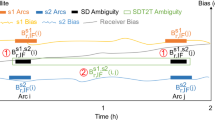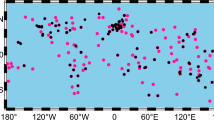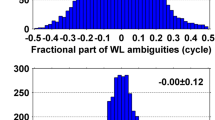Abstract
Single-difference (SD) ambiguity resolution (AR) and track-to-track (T2T) AR are two typical AR methods in precise orbit determination (POD) for Low Earth Orbit (LEO) satellites, which could improve the accuracy of orbits greatly. In this study, SD AR and T2T AR methods are introduced and analyzed. The performance of these two methods is assessed by three months of GPS observations from the Gravity Recovery and Climate Experiment Follow On (GRACE-FO) twin satellites. Results show that T2T AR is highly dependent on the stability of receiver hardware delays, while SD AR requires Fractional Cycle Bias (FCB) or Integer Recovery Clock (IRC) products. We find that these two methods have comparable performance in Reduced Dynamic Precise Orbit Determination (RDPOD), while SD AR slightly outperforms T2T AR in Kinematic Precise Orbit Determination (KPOD). We also find that SD AR has a higher AR success rate than T2T AR. Therefore, we recommend SD AR as the top choice in LEO orbit determination, and T2T AR can be a good alternative when FCB or IRC products are not available.













Similar content being viewed by others
Data availability
The CODE precise orbit and clock products can be found from the Web site of IGS data center of Wuhan University via ftp://igs.gnsswhu.cn/pub/gnss/products/mgex/. The GRACE-FO data are provided by JPL via ftp://rz-vm152.gfz-potsdam.de/. The SLR tracking data are obtained from ftp://cddis.gsfc.nasa.gov/pub/slr/data/, and the F10.7 data and geomagnetic data are from ftp://ftp.swpc.noaa.gov/.
References
Arnold D, Schaer S, Villiger A, Dach R, Jäggi A (2019) Single-receiver ambiguity fixing for GPS-based precise orbit determination of low Earth orbiters using CODE’s new clock and phase bias products. Geophys Res Abstr 21:1
Berger C, Biancale R, Ill M, Barlier F (1998) Improvement of the empirical thermospheric model DTM: DTM94 - a comparative review of various temporal variations and prospects in space geodesy applications. J Geodesy 72(3):161–178
Blewitt G (1989) Carrier phase ambiguity resolution for the global positioning system applied to geodetic baselines up to 2,000 km. J Geophys Res 94(B8):10187–10203
Chen H, Jiang W, Ge M, Wickert J, Schuh H (2014) An enhanced strategy for GNSS data processing of massive networks. J Geodesy 88:857–867
Dong D, Bock Y (1989) Global positioning system network analysis with phase ambiguity resolution applied to crustal deformation studies in California. J Geophys Res 94(B4):3949–3966
Ge M, Gendt G, Dick G, Zhang F, Rothacher M (2006) A new data processing strategy for huge GNSS global networks. J Geodesy 80(4):199–203
Ge M, Gendt G, Rothacher M, Shi C, Liu J (2008) Resolution of GPS carrier-phase ambiguities in precise point positioning (PPP) with daily observations. J Geodesy 82:389–399
Guo J, Kong Q, Qin J et al (2013) On precise orbit determination of HY-2 with space geodetic techniques. Acta Geophys 61(3):752–772
Guo X, Geng J, Chen X et al (2020) Enhanced orbit determination for formation-flying satellites through integrated single- and double-difference GPS ambiguity resolution. GPS Solut 24(1):14
Jäggi A, Dahle C, Arnold D, Bock H, Meyer U, Beutler G, van den IJssel J. (2016) Swarm kinematic orbits and gravity fields from 18 months of GPS data. Adv Space Res 57(1):218–233
Laurichesse D, Mercier F, Berthias J, Broca P, Cerri L (2009) Integer ambiguity resolution on undifferenced GPS phase measurements and Its application to PPP and satellite precise orbit determination. Navigation 56(2):135–149
Li J, Zhang S, Zou X, Jiang W (2010) Precise orbit determination for GRACE with zero-difference kinematic method. Chin Sci Bull 55(07):600–606
Li X, Zhang X, Li P (2012) PPP for rapid precise positioning and orbit determination with zero-difference integer ambiguity fixing. Chin J Geophys Chin Ed 55(3):833–840
Li P, Zhang X, Ren X, Zuo X, Pan Y (2016) Generating GPS satellite fractional cycle bias for ambiguity-fixed precise point positioning. GPS Solut 20(4):771–782
Li X, Wu J, Zhang K, Li X, Xiong Y, Zhang Q (2019) Real-time kinematic precise orbit determination for LEO Satellites using zero-differenced ambiguity resolution. Remote Sens 11:2815
Liu Y, Ge M, Shi C, Lou Y, Jens W, Harald S (2015) Improving GLONASS precise orbit determination through data connection. Sensors 15(12):30104–30114
Loyer S, Perosanz F, Mercier F, Capdeville H, Marty JC (2012) Zero-difference GPS ambiguity resolution at CNES-CLS IGS analysis center. J Geodesy 86(11):991
Lu C, Zhang Q, Zhang K, Zhu Y, Zhang W (2019) Improving LEO precise orbit determination with BDS PCV calibration. GPS Solut 23(4):1–13
Malys S, Jensen PA (1990) Geodetic point positioning with GPS carrier beat phase data from the CASA UNO experiment. Geophys Res Lett 17(5):651–654
Melbourne W (1985) The case for ranging in GPS-based geodetic systems. First International Symposium on Precise Positioning with the Global Positioning System, Rockville
Milani A, Nobili AM, Farinella P (1987) Non-gravitational perturbations and satellite geodesy. Adam Hilger, Bristol
Montenbruck O, Hackel S, Ijssel J, Arnold D (2018a) Reduced dynamic and kinematic precise orbit determination for the Swarm mission from 4 years of GPS tracking. GPS Solut 22(3):79
Montenbruck O, Hackel S, Jaggi A (2018b) Precise orbit determination of the Sentinel-3A altimetry satellite using ambiguity-fixed GPS carrier phase observations. J Geodesy 92(7):711–726
Montenbruck O, André H, Langley R, Siemes C (2019) CASSIOPE orbit and attitude determination using commercial off-the-shelf GPS receivers. GPS Solut 23(4):1–12
Pearlman M, Degnan J, Bosworth J (2002) The international laser ranging service. Adv Space Res 30(2):135–143
Renga A, Causa F, Tancredi U, Grassi M (2018) Accurate ionospheric delay model for real-time GPS-based positioning of LEO satellites using horizontal VTEC gradient estimation. GPS Solut 22(2):46
Hatch Ron (1982) The synergism of GPS code and carrier measurements. Proceedings of the third international symposium on satellite Doppler positioning at physical sciences laboratory of New Mexico State University, Feb. 8–12, Vol 2, pp 1213–1231
Svehla D (2018) Track-to-track ambiguity resolution for zero-differences—integer phase clocks. Springer theses (recognizing outstanding Ph.D. research): Geometrical theory of satellite orbits and gravity field, Springer, Cham
Teunissen P (1995) The least-squares ambiguity decorrelation adjustment a method for fast GPS integer ambiguity estimation. J Geodesy 70:65–82
Wermuth M, Montenbruck O, van Helleputte T (2010) GPS high precision orbit determination software tools (GHOST). In: 4th International conference on astrodynamics tools and techniques, 3–6, May 2010, Madrid
Won C, Jeong L (2015) An effective range ambiguity resolution for LEO satellite with unknown phase deviation. Ice Trans Commun 99(2):533–541
Wu S, Yunck T, Thornton C (1988) Reduced-dynamic technique for precise orbit determination of low earth satellites. J Guid Control Dyn 14(1):2143–2153
Wübbena G (1985) Software developments for geodetic positioning with GPS using TI-4100 code and carrier measurements. Rockville: first international symposium on precise positioning with the global positioning system, Rockville, US, pp 403–412
Yuan L, Jin S, Hoque M (2020) Estimation of LEO-GPS receiver differential code bias based on inequality constrained least square and multi-layer mapping function. GPS Solut 24(2):1–12
Yunck T, Wu S, Wu J, Thornton C (1990) Precise tracking of remote sensing satellites with the global positioning system. IEEE Trans Geosci Remote Sens 28(1):108–116
Yunck T, Bertiger W, Wu S et al (1994) First assessment of GPS-based reduced dynamic orbit determination on TOPEX/Poseidon. Geophys Res Lett 21(7):541–544
Zhang X, Li P, Guo F (2013a) Ambiguity resolution in precise point positioning with hourly data for global single receiver. Adv Space Res 51(1):153–161
Zhang X, Li P, Zuo X (2013b) Kinematic precise orbit determination based on ambiguity-fixed PPP. Geomat Info Sci Wuhan Univ 38(9):1009–1013
Zhou X, Jiang W, Chen H, Li Z, Liu X (2019) Improving the GRACE kinematic precise orbit determination through modified clock estimating. Sensors 19(19):4347
Zumberge J, Heflin M, Jefferson D et al (1997) Precise point positioning for the efficient and robust analysis of GPS data from large networks. J Geophys Res Solid Earth 102(B3):5005–5017
Acknowledgements
Thanks to IGS, CODE, and ILRS for providing GNSS data, precise products, and SLR data. Thanks to JPL and GFZ for providing GRACE-FO data. Thanks to SWPC/NOAA for the F10.7 data and geomagnetic data. This research was funded by the National Natural Science Foundation of China (No. 41704030), Natural Science Innovation Group Foundation of China (No. 41721003), and National Science Fund for Distinguished Young Scholars (No. 41525014).
Author information
Authors and Affiliations
Corresponding author
Additional information
Publisher's Note
Springer Nature remains neutral with regard to jurisdictional claims in published maps and institutional affiliations.
Rights and permissions
About this article
Cite this article
Zhou, X., Chen, H., Fan, W. et al. Assessment of single-difference and track-to-track ambiguity resolution in LEO precise orbit determination. GPS Solut 25, 62 (2021). https://doi.org/10.1007/s10291-021-01103-4
Received:
Accepted:
Published:
DOI: https://doi.org/10.1007/s10291-021-01103-4




